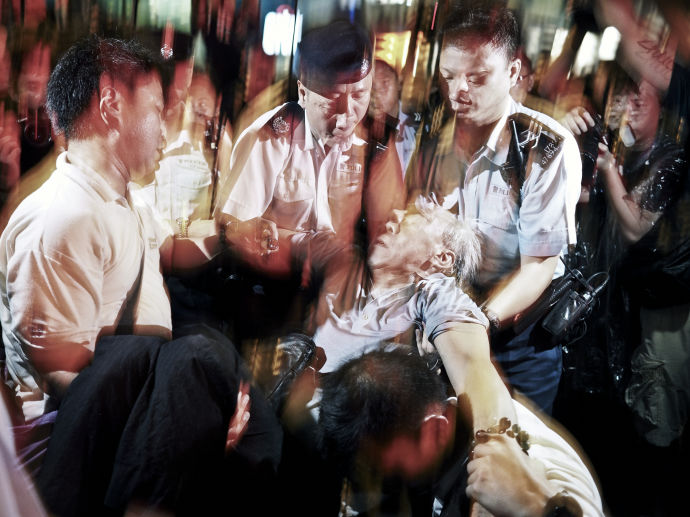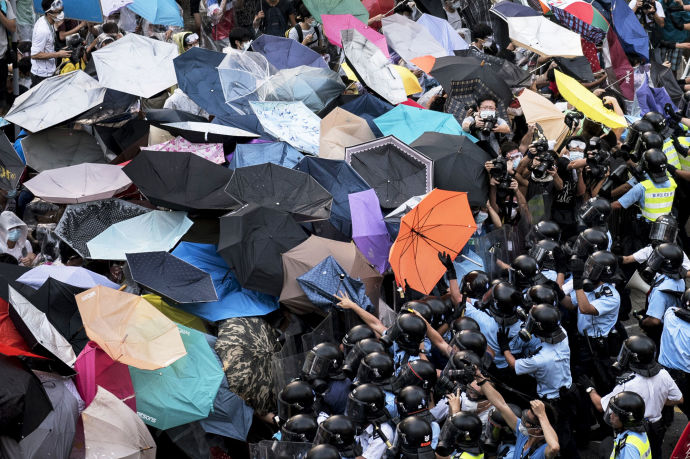Occupy Central Encounters a Class Problem
By Suzanne Sataline
October 3, 2014
![]()
On a steamy Friday evening, splendid air conditioning and the promise of a bargain drew hundreds of shoppers to Hong Kong’s Causeway Bay district. All week, the district had been the site of a satellite protest that had spun off from the massive gathering outside of government offices. In Causeway, students participating in protests begun last Friday had blocked traffic by tying together metal barricades, turning one of the city’s most polluted districts into a freewheeling pedestrian zone filled with singing, chatting youth. Into this scene walked some twenty beefy men in tight formation, wearing surgical masks.
They shoved aside the metal gates, sending some crashing to the ground. One guy in a light-blue T-shirt grabbed a skinny student around the neck. Another masked man punched and stomped on a student. Police arrived wearing neon vests, and students beseeched them to make arrests. According to witnesses, officers took the men away, but didn’t arrest them on the scene. Standing nearby an hour later, a twenty-four-year-old named Colin Au was still seething. The men, he claimed, were paid enforcers. “The plan of the government is to try to scare us away, to use every means to stop the occupiers from coming onto the street,’’ he said, to the nods of people around.
Across Victoria Harbor from Hong Kong Island, a mob attacked students and supporters at another encampment, injuring several people. The violence in the area of Kowloon had begun in the afternoon, when a large group of men descended on the few remaining protesters at a satellite gathering in Mong Kok, a sprawling shopping district that draws tourists and the city’s working class. Well past midnight, live television broadcasts showed what appeared to be adult men pouncing on and pummeling students. Residents screamed at the outnumbered police officers who were attempting to break up fights and make arrests. When officers cleared narrow paths through the crowd, leading out shaking students, people in the crowd shoved and hit some, screaming, “Go home!” Police arrested nineteen people and confirmed that eight of them had triad backgrounds. By dawn, protesters had begun to rebuild their camp.
The goals of the main protest group, Occupy Central with Love and Peace, had been to paralyze Central, the main business district, and to convince China to scrap a restrictive elections process that would let Beijing screen a few candidates to run for chief executive in 2017. Protesters vowed to strangle the financial heart of the city, choking off access to international banks, financial-service firms, and luxury stores like Prada and Chanel. But college and high-school students preëmpted those plans, starting with a boycott of classes in September, and the protests took root in the nearby Admiralty district instead. There, police used tear gas on demonstrators—a decision that, as I wrote for this site on Wednesday, helped grow the protests.
With Admiralty crammed, the students and other protesters branched out, hoping to spread their message to other neighborhoods. They created a protest zone east of the main movement, in Causeway Bay, and north of the island, in Mong Kok, drawing in some elderly and working-class residents. People remained enthusiastic and generally supportive across two days of holidays, but when Friday broke and work resumed, many other residents were in no mood to slog through longer commutes in hopes of forcing C. Y. Leung, Hong Kong’s chief executive, to resign, or Beijing to relent on its electoral policies. On Friday, Leung refused to step down, and after the violence began a student group withdrew from talks that had opened a day earlier.
Most everyone in Hong Kong has been inconvenienced by the occupation. Bus companies have halted or modified routes, putting pressure on the city’s already jammed subways. And the detours and roadblocks have disproportionately affected those who drive, including many blue-collar workers. With a large span of highway hosting a protest encampment, cars and taxis have been forced into circuitous routes around the base of the island’s mountains. Tradespeople and deliverymen, and the tiny stores and restaurants that depend on them, have lost hours and money. In a place where practicality is a virtue, the quest for self-governance might appear frivolous to them. Paul Zimmerman, a district councillor for Causeway Bay, told a crowd on Friday that he had received complaints about people unable to get to work or see doctors. “Slowly you will lose your support,’’ he said.
Occupy Central, at the outset, was a movement of university students, professors, and young white-collar workers. It now has a class problem. Around the corner from the Causeway Bay attack, on Jardine’s Bazaar, a shoving match lasted for more than an hour. Before a hundred or more onlookers, men screamed at the few remaining democracy advocates, attired in the black shirts and yellow ribbons that have become their de-facto uniform. “You want to get democracy? So do I!” a man in a purple polo shirt shouted in Cantonese. “But I have a right to go to work!”

